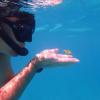Hello everybody,
My name is Brett Smith, and I wanted share an open source remote monitoring buoy we have been working on in Seychelles as part of our company named "OceanLabs."
Really, there are 6 remote monitoring buoys - because we have one design that is made from recycled DFAD buoys and another that can be sourced from scratch.
In addition, both designs can be configured as either a hydrophone, a camera, or water quality monitor.
The video below really outlines its systems the best.
We did a lot of design work for this project:
- We took apart 3 DFAD buoys and re-used some of their circuits in our deployments - notably solar panels, batteries, and solar chargers.
- We molded our own hydrophone and made our own amplifier boards.
- We designed an ultra low power real time clock that is responsibe for power scheduling monitoring devices.
- We created a standardized mounting system for embedding electronics projects inside PVC pipe.
- We wrote some decent computer vision code for object detection pre-processing - including background image removal to isolate moving objects for image recognition.
We also did quite a few test deployments via shore diving, and got some initial results:
- Verified power system
- 3 days of water quality data (pH, DO, temperature, & buoy motion)
- 2 hours of live video footage
- 2 hours of live audio steam
This was all before we even knew about the wildlabs community! You can imagine how excited I was to find this group!
My specialty is in electrical engineering and software development, so I cannot wait to dig in and see what we can learn and what we can do to help support the group here!
Feel free to send me direct messages, questions, comments, concerns etc
I am on whatsapp, signal, & discord.
I will definitely continue to post some of the technical work we've done in smaller chunks if people are interested.
Cheers!
Brett
15 January 2024 9:17pm
Hello fellow Brett. Cool project. You mentioned a waterseal testing process. Is there documentation on that?




Brett Muir